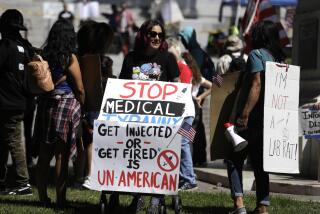Scientists Urged to Ease Threats of Global War
- Share via
The threat of global war is so great that people all over the world need to rethink their ideas about national security, scientists were told here Sunday as the 151st national meeting of the American Assn. for the Advancement of Science got under way.
The role of the scientist in matters of war is a major theme in the weeklong conference.
John D. Marks, executive director of the Washington-based Search for Common Ground, chaired a workshop session designed to challenge scientists to think more deeply about the causes of international conflict. The free-swinging discussion brought spirited rebuttals, however, from some participants who questioned the value of such discussions in this country if the people of the Soviet Union do not have an equal opportunity to bring about change in their country’s posture.
“Nothing can happen as long as the Iron Curtain remains in place,” one scientist said with more than a little hostility.
Marks, however, said that the thirst for peace is universal and that the greatest obstacle lies in attitudes toward how that goal can be achieved.
“If you scratch deep enough, people want the same thing,” said Marks, who has presented the same program in several countries. “But our political process doesn’t get us there.”
The political process, however, can have a major impact, he said.
Marks cited the change in attitudes toward China after President Richard M. Nixon’s historic visit to that country in 1972. Before the President’s trip, Marks said, China represented the “yellow peril.” After the trip, China was viewed in this country as an ally that could do no wrong.
China has not changed, he said. Only our perception of it has changed.
“We were looking at it through a new prism,” he said.
“How can we do that with the Soviets?” he asked.
An anthropologist in the audience suggested that although the process worked with China, it might not work with the Soviet Union. It worked with China, she said, because the President’s trip helped turn China against a much more powerful enemy, the Soviet Union.
Common Enemy
It might be more effective, she added, to find a common enemy that would unite the United States and the Soviet Union in the need to overpower a far greater threat.
Perhaps, Marks suggested, that threat could be the possession of nuclear arms by radicals in such countries as Iran.
As might be expected, an issue that has perplexed scholars throughout history was not resolved during the three-hour workshop. Marks, however, left the scientists with a gimmick that, if nothing else, will be entertaining during the hours and hours of meetings this week.
He asked each of those present to grasp one finger by the other hand, then try to pull the finger out.
Instinctively, as each person tried to withdraw the finger, the grip was tightened proportionately.
“Now,” he said, “push the finger in slightly and then quickly withdraw it.”
The forward motion served to relax the grip, and the finger could be withdrawn easily.
That, he said, shows what can be done if one is willing to give a little before taking.
The convention, which will continue through Friday at the downtown Hilton and Bonaventure, includes a section on “arms control and national security,” reflecting broad concern for the role of scientists in that area.
Among topics to be discussed are the politics of weapons in space, featuring Gerold Yonas, chief scientist with the Strategic Defense Initiative Organization, and Richard Garwin, a national defense expert who is a sharp critic of the Reagan Administration’s proposed “Star Wars” defense plan. That debate is scheduled for today.
Arms Reduction
Later in the week, scientists will grapple with the topics of arms reduction and control, the comprehensive test ban treaty, nonproliferation of nuclear weapons, the technical bases of treaty verification and responsibility of scientists for nuclear weapons.
That range of discussions reflects the nature of this meeting, designed to expose scientists to a wide range of topics in the hopes of stimulating cross-fertilization among the disciplines.






